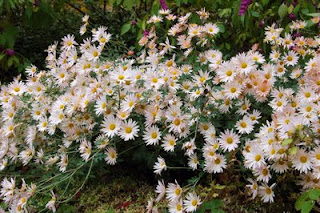


 (Photos: American beautyberry, daisy-flowered mum, bi-colored French marigold, crape myrtle)
(Photos: American beautyberry, daisy-flowered mum, bi-colored French marigold, crape myrtle)This is a great time to go around your yard and garden and see what places have fall color and what places need more fall color (yes there is lots of fall color in the trees, like my lovely crape myrtles turning golden yellow, but you need to plan for fall color in the flower garden). It is also a good time of year to visit plant nurseries and botanical gardens to see what is dazzling in the fall. Last time I wrote about my beautiful pineapple sage, and how it is now giving a gorgeous burst of red bloom in the garden, when many plants are slowing down for the inevitable first frost. One plant I have fallen in love with, that gives exotic fall color, yet is a Virginia native, is Callicarpa virginica or American Beautyberry. It is an inconspicuous plant most of the year with small, unremarkable flowers and leaves. But in the fall, as its berries ripen to a startling light purple to mauve- it is a show stopper! It is an incredibly easy shrub, not needing much special by the way of soil conditions and I have never fertilized mine. I highly recommend this plant!
Mums are another reliable source of fall color and cuttings for the house. I prefer bi-colored and daisy-flowered mums (I like bi-colored anything...). I trim them back until June, then let them get just a little bit rangy and less controlled than plants trimmed to a later date in the summer- I think they look more natural in the garden this way. Here in central VA, I have had had good luck planting even what are considered "florists" mums, after I have enjoyed them in the house for a bit. Our climate is easy on these plants, but hardy mums would be a better choice further north.
Some annuals really put their heart into blooming as the days get colder and shorter, like the French marigold that volunteer in my veg garden every year. Another easy to care for plant, that I also recommend. Oh, I know it is common and not trendy, but it is sturdy, reliable, pretty all season and self-sows...and is giving a burst of bloom right now!
So, spend some time walking the yard and plant nurseries and plan for fall color next year. When spring comes, you will be ready to start planting!
Happy gardening!





